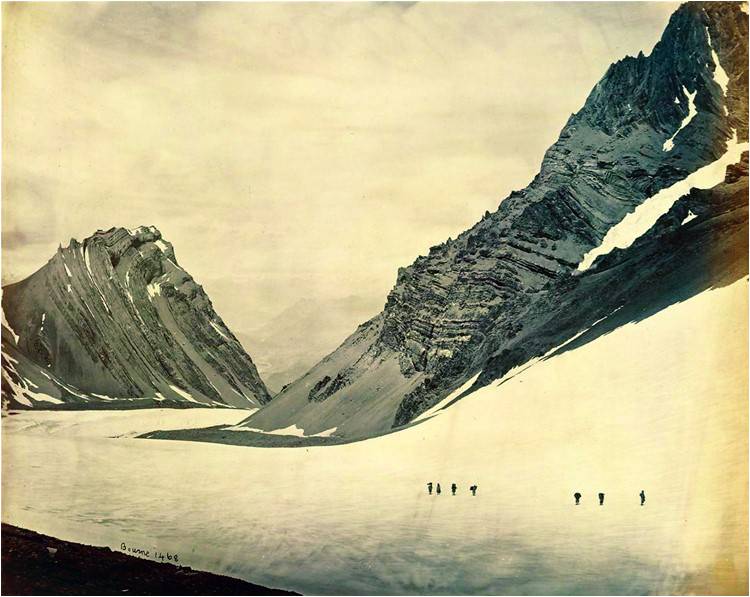
After some initial success as a professional photographer in England, Samuel Bourne sailed to India in 1863 and soon after his arrival opened a studio in Simla. From there he embarked on three successive photographic expeditions to the Himalayas, which brought him wide recognition and which he described in the pages of the British Journal of Photography in issues dating from 1864 to 1870.
This photograph of the Manirung Pass was captured in 1866 on the last and most strenuous of the expeditions, the destination of which was the source of the Ganges. Accompanied by the botanist and geologist G. R. Playfair, Bourne enlisted a team of 80 porters who drove a food supply of sheep and goats and carried boxes of chemicals, glass plates, and a portable darkroom tent. Crossing the pass at an elevation of 18,600 feet, Bourne succeeded in taking three views before the sky clouded over, setting a record for photography at high altitudes. After near-fatal hardships, the expedition reached the ice cave at the foot of Gangotri Glacier, where the Ganges originates, and returned safely to Simla. It was through such feats of physical courage, as well as the obstinate pursuit of the highest artistic standards, that Bourne earned his reputation as a peerless photographer-explorer.
The album of 131 images from which this view is taken includes 68 photographs by Bourne. With a few exceptions all the other images, ranging from cricket games to amateur theatricals and shipwrecks, were made in India. A richly informative document on the subcontinent as viewed through British eyes the album was probably assembled by a British resident in India in the late 1860s.
This photograph of the Manirung Pass was captured in 1866 on the last and most strenuous of the expeditions, the destination of which was the source of the Ganges. Accompanied by the botanist and geologist G. R. Playfair, Bourne enlisted a team of 80 porters who drove a food supply of sheep and goats and carried boxes of chemicals, glass plates, and a portable darkroom tent. Crossing the pass at an elevation of 18,600 feet, Bourne succeeded in taking three views before the sky clouded over, setting a record for photography at high altitudes. After near-fatal hardships, the expedition reached the ice cave at the foot of Gangotri Glacier, where the Ganges originates, and returned safely to Simla. It was through such feats of physical courage, as well as the obstinate pursuit of the highest artistic standards, that Bourne earned his reputation as a peerless photographer-explorer.
The album of 131 images from which this view is taken includes 68 photographs by Bourne. With a few exceptions all the other images, ranging from cricket games to amateur theatricals and shipwrecks, were made in India. A richly informative document on the subcontinent as viewed through British eyes the album was probably assembled by a British resident in India in the late 1860s.

